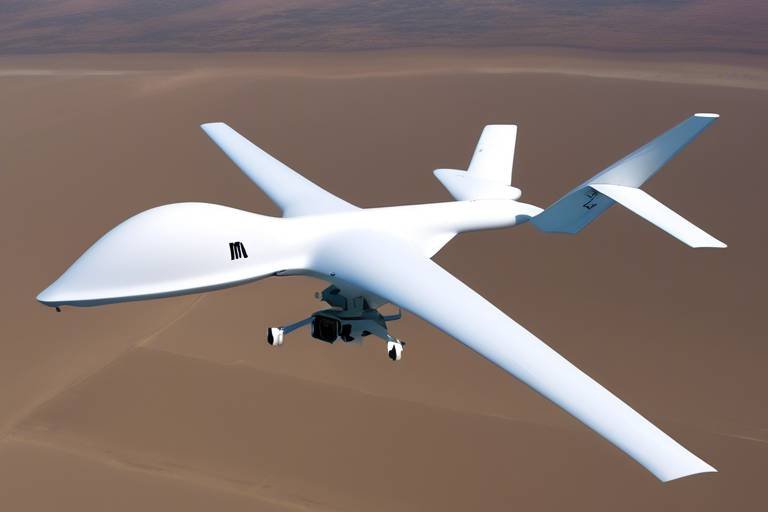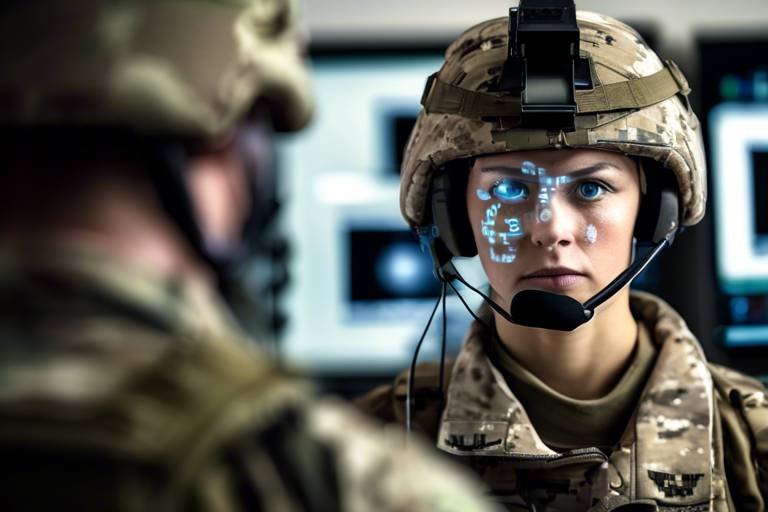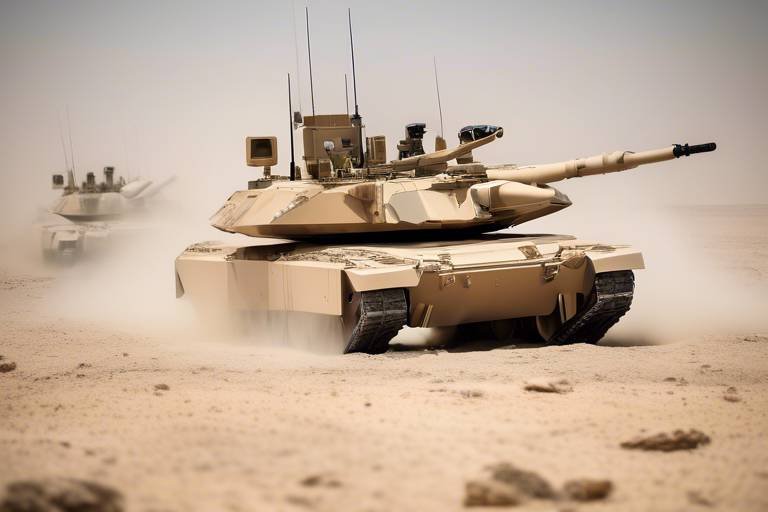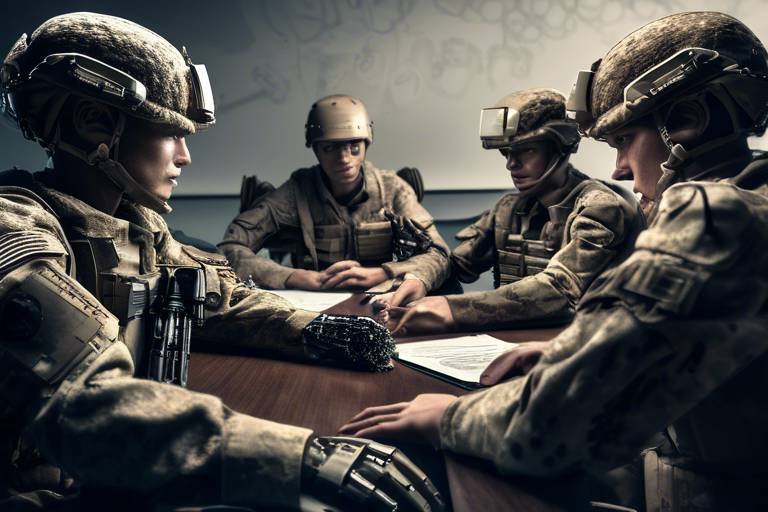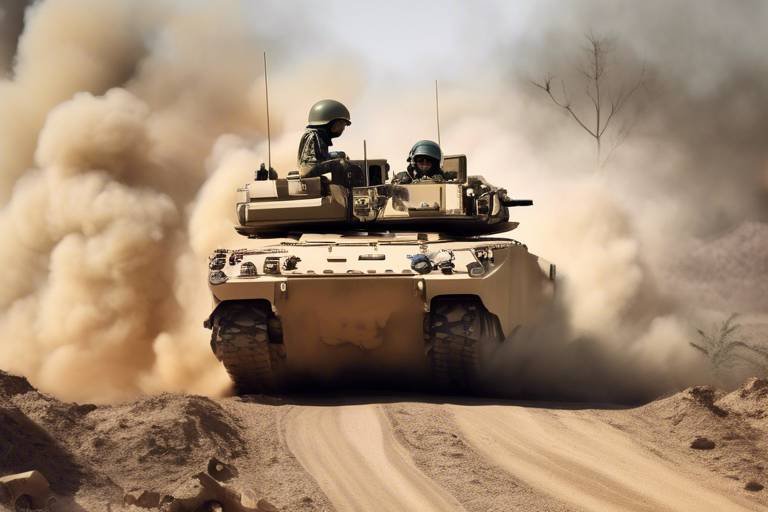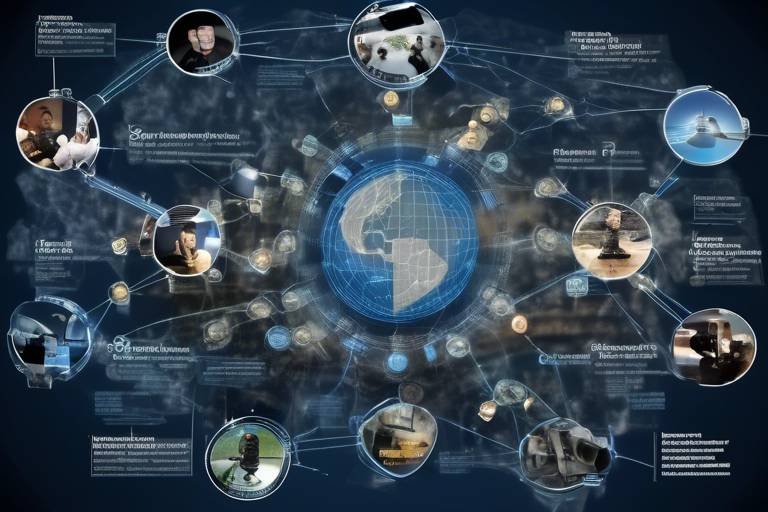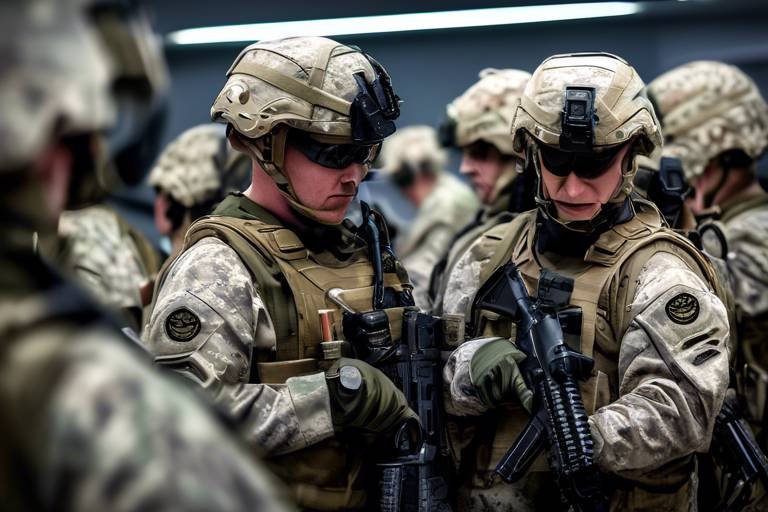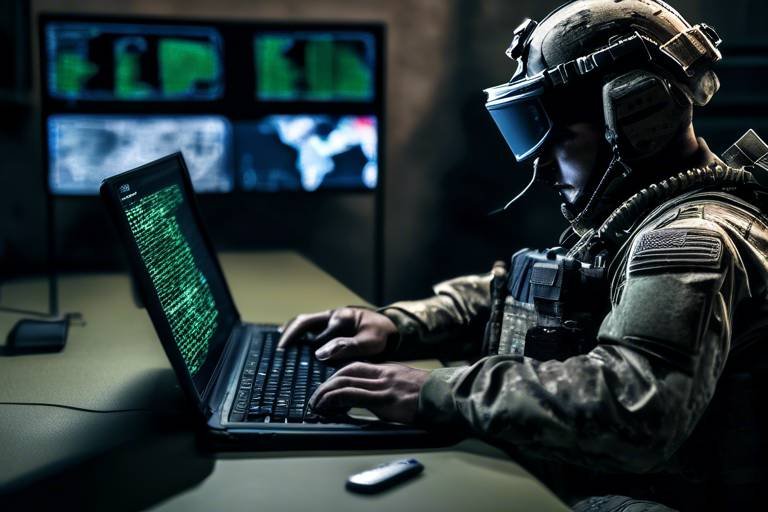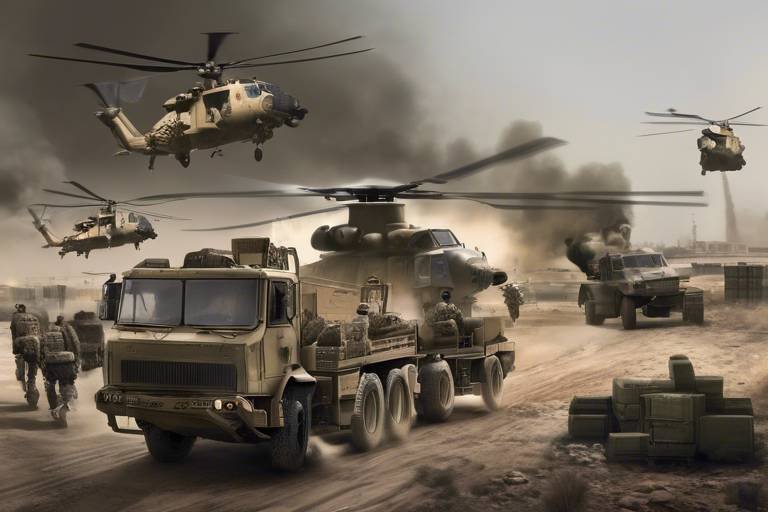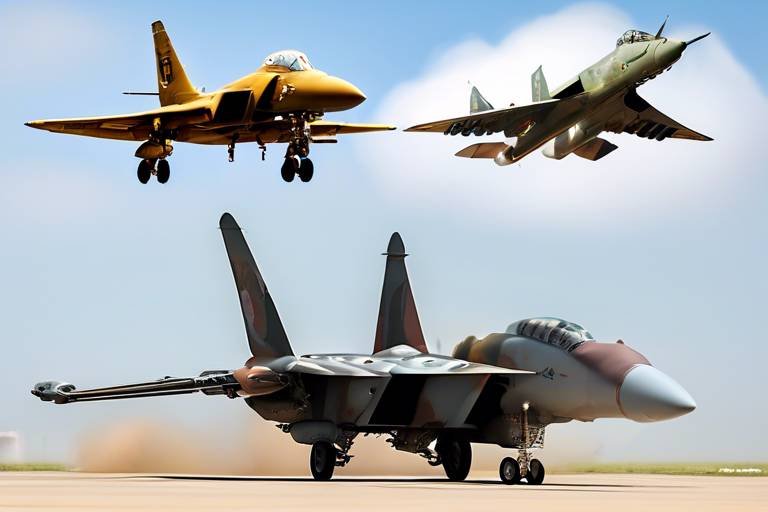Understanding the Impact of Defense Technology on Global Stability
The world we live in today is a complex web of interactions, alliances, and rivalries, all influenced by the rapid advancements in defense technology. As nations invest heavily in cutting-edge military capabilities, the landscape of international relations is undergoing a seismic shift. But what does this mean for global stability? The answer is multifaceted and intriguing. In this article, we will explore how these technological advancements are not just reshaping military strategies but also redefining the very fabric of diplomacy and security.
Firstly, it's essential to recognize that defense technology has a long history of evolution. From the invention of gunpowder to the development of nuclear weapons, each leap forward has altered the balance of power among nations. Today, we stand on the brink of another transformation, driven by innovations in areas such as artificial intelligence, cybersecurity, and space technology. These advancements bring about new capabilities that can enhance national security but also pose significant risks to global peace.
Consider the implications of cyber warfare, a domain that has emerged as a critical battlefield in modern conflicts. Unlike traditional warfare, which often involves physical confrontations, cyber warfare operates in the shadows, targeting essential infrastructure and sensitive information. This new form of conflict raises questions about accountability and the rules of engagement, challenging our understanding of what constitutes an act of war.
Moreover, the rise of artificial intelligence in military applications introduces both opportunities and ethical dilemmas. AI can enhance decision-making processes and improve operational efficiency, but it also raises concerns about autonomous weapons systems making life-and-death decisions without human intervention. As we navigate this new terrain, we must ask ourselves: how do we ensure that technological advancements do not outpace our ethical frameworks?
As we delve deeper into the intricacies of defense technology, we must also consider its impact on arms control agreements. The rapid development of new weapons systems can undermine existing treaties, leading to a breakdown of trust among nations. This erosion of confidence can exacerbate tensions and make disarmament efforts increasingly challenging. The question looms large: how can we foster cooperation in a world where technology evolves faster than our ability to regulate it?
In conclusion, the interplay between defense technology and global stability is a dynamic and evolving narrative. As nations continue to innovate and adapt, the need for dialogue and collaboration becomes ever more critical. The future of international relations will depend on our ability to harness these advancements responsibly, ensuring that they contribute to peace rather than conflict. In the following sections, we will explore specific aspects of defense technology, including cybersecurity, artificial intelligence, and the challenges they present to global stability.
- What is the main impact of defense technology on global stability? Defense technology influences military capabilities and strategies, which can either enhance security or exacerbate tensions among nations.
- How does cybersecurity relate to national defense? Cybersecurity is essential for protecting national infrastructure and sensitive information, making it a critical component of modern defense strategies.
- What are the ethical concerns surrounding artificial intelligence in military applications? The use of AI in military operations raises questions about accountability, decision-making, and the potential for autonomous weapons to operate without human oversight.
- How do advancements in defense technology affect arms control agreements? New technologies can challenge existing treaties, complicating negotiations and enforcement, and undermining trust among nations.

The Evolution of Defense Technology
Throughout history, defense technology has undergone a remarkable transformation, evolving from rudimentary weapons to sophisticated systems that shape the dynamics of global stability. In the early days, warfare was primarily about brute force, with armies relying on basic tools like swords, shields, and catapults. As time marched on, we witnessed the advent of gunpowder, which revolutionized combat and introduced firearms into the battlefield. This marked the beginning of a new era where technology began to dictate the outcomes of conflicts, shifting the balance of power among nations.
Fast forward to the 20th century, and we see a whirlwind of innovations that have dramatically altered military strategies. The introduction of tanks during World War I, the development of aircraft in World War II, and the creation of nuclear weapons fundamentally changed how wars are fought. These advancements not only increased the lethality of military operations but also introduced the concept of deterrence, where the mere possession of advanced weaponry could prevent conflicts from escalating.
In recent decades, the rise of information technology has led to a new paradigm in defense capabilities. The integration of satellites, drones, and intelligent systems has enhanced surveillance, reconnaissance, and precision strikes, allowing nations to engage in conflicts with unprecedented efficiency. This technological leap has also given rise to asymmetric warfare, where smaller, less powerful groups can leverage advanced technologies to challenge traditional military forces.
As we delve deeper into the evolution of defense technology, it's essential to recognize the critical role of research and development (R&D) in shaping military capabilities. Governments and private sectors invest billions of dollars annually in R&D to stay ahead of potential adversaries. This relentless pursuit of innovation has not only led to the creation of advanced weapon systems but also to the development of dual-use technologies that can be applied in civilian contexts, raising questions about regulation and ethical implications.
Moreover, the globalization of technology means that advancements in one nation can have ripple effects worldwide. For instance, the proliferation of cyber capabilities has transformed national defense, making cybersecurity a cornerstone of military strategy. Nations are now investing heavily in protecting their digital infrastructure, recognizing that the battlefield of the future extends beyond physical borders and into cyberspace.
In summary, the evolution of defense technology is a testament to human ingenuity and the relentless quest for security. As we continue to innovate, the challenge lies in ensuring that these advancements contribute to global stability rather than exacerbate tensions. The balance of power is constantly shifting, and understanding the historical context of defense technology is crucial for navigating the complexities of international relations today.

Cybersecurity and National Defense
In today's interconnected world, cybersecurity has emerged as a cornerstone of national defense strategies across the globe. The rapid advancement of technology has not only transformed the battlefield but has also reshaped how nations protect their critical infrastructure and sensitive information. With the rise of the digital age, threats have evolved from traditional military confrontations to cyber attacks that can cripple economies and disrupt essential services without a single shot being fired.
Consider this: a well-coordinated cyber attack can paralyze a nation's power grid, disrupt financial systems, or even manipulate public opinion through misinformation. This is not just a theoretical scenario; it has happened before, and the implications are staggering. Nations are now investing heavily in cybersecurity measures, understanding that a strong defense in the cyber realm is as crucial as conventional military strength.
Moreover, the relationship between cybersecurity and national defense is a two-way street. As nations bolster their cyber defenses, they also need to address the implications of these technologies on international relations. For instance, when one country enhances its cyber capabilities, it can create a sense of mistrust among its neighbors, leading to an arms race not of missiles, but of malware and hacking tools. This dynamic can significantly impact global stability, as nations may feel compelled to respond with their own cyber enhancements, creating a precarious balance.
In response to these challenges, countries are adopting various strategies to enhance their cybersecurity posture. These strategies often include:
- Investment in advanced cybersecurity technologies
- Collaboration with international partners to share intelligence
- Establishing robust incident response frameworks
- Public-private partnerships to secure critical infrastructure
These initiatives are vital for creating a resilient national defense strategy that can withstand the evolving landscape of cyber threats. However, the complexity of cyber warfare makes it essential for nations to work together, sharing knowledge and resources to combat common threats. After all, in the realm of cybersecurity, a collective approach is often more effective than isolated efforts.
As we delve deeper into the implications of cybersecurity on national defense, it's essential to recognize that this is not just a technical issue but a matter of national security. Governments must prioritize cybersecurity at the highest levels, integrating it into their defense policies and ensuring that all sectors of society are aware of the threats and prepared to respond. The future of warfare may very well depend on how adeptly nations can navigate this complex cyber landscape.
- What is cybersecurity's role in national defense? Cybersecurity protects a nation's critical infrastructure and sensitive information from cyber threats, ensuring national security in a digital age.
- How do cyber attacks affect international relations? Cyber attacks can create mistrust among nations, leading to an arms race in cyber capabilities and destabilizing global relations.
- What strategies are nations using to combat cyber threats? Nations are investing in advanced technologies, fostering international collaboration, and creating public-private partnerships to enhance their cybersecurity defenses.

The Rise of Cyber Warfare
In today's interconnected world, the concept of warfare has evolved dramatically. Gone are the days when battles were fought solely on land, sea, or air. Now, we find ourselves in an era where cyber warfare has emerged as a formidable threat to national security. This shift is not just a minor adjustment; it represents a fundamental transformation in how conflicts are initiated and conducted. Imagine a battlefield where the weapons are not tanks or aircraft, but lines of code and digital exploits. It's a realm where the potential for disruption is immense, and the consequences can ripple across nations.
Cyber warfare refers to the use of digital attacks by one nation to disrupt the vital computer systems of another, aiming to create chaos, steal sensitive information, or undermine national security. This phenomenon is increasingly prevalent, with state-sponsored hacking groups and rogue actors engaging in activities that can destabilize entire nations. For instance, attacks on critical infrastructure—like power grids or financial systems—can have devastating effects, leading to not just economic turmoil but also loss of life. The implications for global stability are profound, as these cyber tactics blur the lines between war and peace.
To illustrate the gravity of this issue, consider the following statistics:
| Year | Notable Cyber Attacks | Impact |
|---|---|---|
| 2007 | Estonia Cyber Attacks | Disruption of government and media websites |
| 2010 | Stuxnet Worm | Targeted Iran's nuclear program |
| 2016 | Yahoo Data Breach | Data of 3 billion accounts compromised |
| 2020 | SolarWinds Hack | Compromised multiple U.S. government agencies |
These incidents are just the tip of the iceberg. The rise of cyber warfare has not only changed the landscape of military strategy but has also raised significant ethical and legal questions. For example, how do we define an act of war in the cyber realm? If a nation conducts a cyber attack that causes physical damage or loss of life, does that warrant a military response? As these questions linger, nations are forced to reevaluate their defense strategies and international norms.
Moreover, the asymmetry of cyber warfare poses a unique challenge. Smaller nations or non-state actors can inflict damage on larger, more powerful nations without the need for traditional military resources. This democratization of warfare creates an environment where anyone with the right skills and resources can potentially disrupt a superpower. It’s akin to a David versus Goliath scenario, but in the digital realm, David often has the upper hand.
As we look to the future, it is clear that cyber warfare will continue to evolve. Nations are investing heavily in cyber defense capabilities, recognizing that the next major conflict may very well be fought in cyberspace. This arms race in digital technology is not just about developing better defenses; it’s also about offensive capabilities. Countries are now considering preemptive cyber strikes as a legitimate strategy, further complicating the already intricate web of international relations.
In conclusion, the rise of cyber warfare is reshaping the very fabric of global security. As nations grapple with the implications of these new forms of conflict, the need for robust cybersecurity measures, international cooperation, and clear definitions of warfare becomes increasingly urgent. The battlefield may have changed, but the stakes remain as high as ever.
- What is cyber warfare? Cyber warfare involves the use of digital attacks to disrupt or damage a nation's vital systems.
- How does cyber warfare differ from traditional warfare? Unlike traditional warfare, cyber warfare can be conducted remotely and often anonymously, making attribution difficult.
- What are the implications of cyber warfare for global stability? Cyber warfare can lead to economic disruptions, loss of life, and increased tensions between nations, thereby threatening global stability.
- How can nations defend against cyber warfare? Nations can enhance their cybersecurity measures, invest in cyber defense technologies, and foster international cooperation to combat cyber threats.

Case Studies in Cyber Attacks
In the realm of cybersecurity, understanding the implications of real-world incidents is crucial for grasping the broader effects on international relations and global stability. Cyber attacks have evolved from mere nuisances to significant threats that can destabilize nations and disrupt peace. Let's delve into some notable case studies that illustrate the severity and consequences of these cyber intrusions.
One of the most infamous examples is the Stuxnet worm, which was discovered in 2010. This sophisticated piece of malware was designed to target Iran's nuclear facilities, specifically the centrifuges at Natanz. What makes Stuxnet particularly fascinating is not just its technical complexity but its geopolitical implications. By sabotaging Iran's nuclear ambitions, this cyber attack sent shockwaves through international relations, raising questions about state-sponsored cyber warfare and the acceptable limits of technological intervention in foreign affairs.
Another significant case is the 2016 U.S. Presidential Election interference, where Russian hackers infiltrated the Democratic National Committee (DNC) and leaked sensitive information. This incident highlighted how cyber attacks could influence democratic processes and public opinion. The repercussions were felt not only in the United States but also across the globe, as trust in electoral systems was undermined. This case serves as a stark reminder that cyber warfare can extend beyond military targets, affecting the very foundations of democracy.
Additionally, the WannaCry ransomware attack in 2017 affected hundreds of thousands of computers across 150 countries, crippling major organizations, including the UK's National Health Service (NHS). The attack demonstrated how vulnerabilities in cybersecurity could lead to widespread chaos, affecting critical infrastructure and public services. The global response to WannaCry emphasized the need for international cooperation in cybersecurity, as the repercussions of such attacks do not respect national borders.
To better understand the impact of these attacks, consider the following table that summarizes key case studies:
| Cyber Attack | Year | Target | Implications |
|---|---|---|---|
| Stuxnet | 2010 | Iran's Nuclear Facilities | State-sponsored cyber warfare; geopolitical tensions |
| 2016 U.S. Presidential Election | 2016 | Democratic National Committee | Influence on democracy; trust erosion |
| WannaCry | 2017 | Global Organizations | Critical infrastructure disruption; need for cooperation |
These case studies illustrate that cyber attacks are not just technical challenges; they are complex events with far-reaching consequences that can affect global stability. The interconnectedness of our digital world means that a breach in one nation can ripple across the globe, prompting nations to rethink their cybersecurity strategies and international collaborations. As we continue to innovate in technology, understanding these implications becomes increasingly vital for maintaining peace and security.
- What is a cyber attack? A cyber attack is an attempt to damage, disrupt, or gain unauthorized access to computer systems or networks.
- How can countries protect themselves from cyber attacks? Countries can implement robust cybersecurity measures, invest in technology, and collaborate internationally to share intelligence and best practices.
- What are the consequences of a successful cyber attack? Consequences can include financial loss, data breaches, disruption of services, and damage to national security.
- Are cyber attacks considered acts of war? The classification of cyber attacks as acts of war is still debated and depends on the scale and impact of the attack.

Defense Strategies Against Cyber Threats
In an era where cyber threats loom large, nations are compelled to adopt robust defense strategies to safeguard their national security. The digital battlefield is unlike any other; it’s dynamic, unpredictable, and often invisible. As governments and organizations increasingly rely on technology, the stakes are higher than ever. So, what can countries do to fortify their defenses against these elusive threats?
One of the primary strategies involves investing in advanced cybersecurity technologies. This means deploying sophisticated firewalls, intrusion detection systems, and encryption protocols to protect sensitive data. But technology alone isn't enough. Human factors play a crucial role in cybersecurity. Training personnel to recognize phishing attempts and social engineering tactics is essential. After all, a well-informed employee can be the first line of defense against cyber attacks.
Moreover, collaboration is key in the fight against cyber threats. Nations are increasingly forming alliances to share intelligence and best practices. For instance, the establishment of international cybersecurity frameworks allows countries to work together, sharing critical information about emerging threats and vulnerabilities. This collaborative approach not only enhances individual national security but also promotes a more secure global digital environment.
Another critical aspect of defense strategies is the creation of incident response teams. These specialized units are trained to respond quickly and effectively to cyber incidents, minimizing damage and restoring operations. By having a dedicated team, nations can ensure they are prepared for any eventuality, whether it’s a minor breach or a full-scale cyber attack.
Additionally, continuous monitoring of networks is vital. Cyber threats evolve rapidly, and a proactive approach is necessary to stay ahead of attackers. Organizations should implement real-time monitoring solutions that can detect unusual activity and trigger alerts. This strategy allows for immediate action, which can significantly reduce the impact of an attack.
Furthermore, the development of cybersecurity policies and regulations plays a pivotal role in shaping a nation’s defense strategy. Governments must establish clear guidelines that dictate how organizations should protect their data and respond to breaches. This not only helps in standardizing security measures but also fosters a culture of accountability among businesses and institutions.
In conclusion, while the landscape of cyber threats continues to evolve, nations can adopt a multifaceted approach to bolster their defenses. By investing in technology, fostering collaboration, establishing rapid response teams, and implementing robust policies, countries can enhance their resilience against cyber attacks. As we move forward, it’s imperative that we remain vigilant and adaptable in our strategies to ensure a secure digital future.
- What are the most common types of cyber threats?
Common types of cyber threats include malware, phishing attacks, ransomware, and denial-of-service attacks.
- How can individuals protect themselves from cyber threats?
Individuals can protect themselves by using strong passwords, enabling two-factor authentication, and being cautious with email links and attachments.
- What role do international organizations play in cyber defense?
International organizations facilitate cooperation among nations, provide guidelines for cybersecurity practices, and help in sharing intelligence about cyber threats.
- Why is training important in cybersecurity?
Training is crucial because human error is often the weakest link in cybersecurity; well-trained employees are better equipped to recognize and respond to threats.

Artificial Intelligence in Military Applications
Artificial Intelligence (AI) is not just a buzzword; it's a revolutionary force reshaping the landscape of military operations. Imagine a battlefield where decisions are made in real-time, with data analyzed at lightning speed, and where machines can predict enemy movements before they even occur. This is the promise of AI in military applications, and it’s not a distant future—it's happening now!
One of the most significant advantages of AI in the military is its ability to process vast amounts of data. Traditional methods of intelligence gathering and analysis can be slow and cumbersome, often leading to missed opportunities or delayed responses. In contrast, AI algorithms can analyze satellite images, social media feeds, and intercepted communications in seconds, providing commanders with actionable insights that can change the course of operations.
However, the integration of AI into military strategies is not without its challenges. The reliance on algorithms raises critical questions about accountability and ethics. For instance, if an AI system makes a decision that leads to civilian casualties, who is responsible? This dilemma is at the forefront of discussions surrounding AI in the military.
Moreover, AI can enhance various military applications, including:
- Autonomous Drones: These unmanned aerial vehicles can conduct surveillance, gather intelligence, and even engage in combat without direct human intervention.
- Predictive Maintenance: AI systems can predict when military equipment is likely to fail, allowing for proactive maintenance that can save lives and resources.
- Cyber Defense: AI can help in identifying and mitigating cyber threats, enhancing national security in an increasingly digital world.
As we delve deeper into the implications of AI in military applications, it’s essential to consider both the potential benefits and the risks involved. On one hand, AI can significantly enhance operational efficiency and effectiveness. On the other hand, the ethical considerations surrounding autonomous weapons and decision-making processes cannot be overlooked. The military must navigate these waters carefully, ensuring that technology serves humanity rather than undermines it.
Looking ahead, the future of AI in military applications will likely involve greater collaboration between humans and machines. While AI can handle data and perform tasks with remarkable speed and accuracy, the human element remains crucial for making nuanced decisions that require empathy, understanding, and moral judgment. As we continue to explore the capabilities of AI, it’s vital to establish guidelines and frameworks that prioritize ethical considerations and human oversight.
- What are the main advantages of using AI in military applications? AI enhances data analysis, improves decision-making speed, and can automate various tasks, leading to increased operational efficiency.
- What ethical concerns are associated with AI in the military? Key concerns include accountability for decisions made by AI systems, potential civilian casualties, and the implications of autonomous weapons.
- How can AI improve cybersecurity in defense? AI can identify and respond to cyber threats more quickly than traditional methods, providing a robust defense against attacks.

Impact on Arms Control Agreements
The landscape of international relations is constantly shifting, and one of the most significant factors influencing this evolution is the advancement of defense technology. As nations develop new military capabilities, the traditional frameworks that govern arms control agreements are increasingly challenged. These agreements, which were once seen as the bedrock of global security, now face scrutiny and strain as technological innovations outpace diplomatic efforts. The rapid pace of change can leave countries scrambling to adapt, often leading to a breakdown in communication and trust.
Historically, arms control agreements have aimed to reduce the likelihood of conflict by limiting the proliferation of certain weapons and technologies. However, with the rise of cutting-edge technologies such as hypersonic missiles, autonomous drones, and cyber warfare capabilities, the effectiveness of these treaties is called into question. For instance, how can nations effectively monitor and verify compliance with agreements when the technologies involved are evolving so rapidly?
Moreover, the introduction of new defense technologies can create an imbalance in power dynamics. Countries that lead in these innovations may gain a significant advantage over others, prompting a new arms race that undermines existing agreements. This situation can lead to a cycle of mistrust, where nations feel compelled to develop their own advanced systems in response, further complicating the arms control landscape.
To illustrate this point, consider the following table, which summarizes the impact of recent technological advancements on key arms control agreements:
| Technology | Impact on Arms Control | Example Agreement |
|---|---|---|
| Hypersonic Missiles | Challenges verification and monitoring | Intermediate-Range Nuclear Forces Treaty (INF) |
| Autonomous Weapons | Raises ethical concerns and complicates accountability | Convention on Certain Conventional Weapons (CCW) |
| Cyber Warfare | Difficulty in defining and regulating cyber capabilities | Various bilateral treaties |
Given these complexities, it is clear that there is an urgent need for nations to revisit and revise arms control agreements to account for these advancements. Diplomatic efforts must focus on creating flexible frameworks that can adapt to technological changes, ensuring that all parties have a clear understanding of what constitutes compliance and accountability. This may involve establishing new verification mechanisms or even developing entirely new agreements that specifically address emerging technologies.
Additionally, the role of international organizations in facilitating dialogue and cooperation cannot be overstated. Organizations such as the United Nations and the Organization for Security and Co-operation in Europe (OSCE) play a crucial role in bringing nations together to discuss arms control issues. By fostering an environment of trust and collaboration, these organizations can help mitigate the risks associated with technological advancements and promote a more stable global landscape.
In conclusion, the impact of defense technology on arms control agreements is profound and multifaceted. As nations navigate this rapidly changing environment, it is essential to prioritize dialogue, trust-building measures, and innovative approaches to arms control. Only by doing so can we hope to maintain global stability in an era defined by technological uncertainty.
- What are arms control agreements? Arms control agreements are treaties between countries aimed at regulating the development, production, stockpiling, and use of weapons to promote international security.
- How does technology affect arms control? Technological advancements can outpace existing agreements, making it difficult to monitor compliance and leading to new power imbalances.
- Why is international cooperation important in arms control? International cooperation fosters trust and communication, which are essential for effective arms control and preventing conflict.

Challenges to Disarmament Efforts
The landscape of global disarmament is increasingly complex, facing numerous challenges that threaten the progress made over the decades. One of the most significant hurdles is the rapid pace of technological advancement. As nations develop new and more sophisticated weapons systems, the original treaties and agreements that aimed to limit arms become outdated. For example, the emergence of hypersonic missiles and autonomous weaponry raises questions about the effectiveness of existing arms control frameworks. How can we negotiate treaties that account for technologies that didn't even exist a few years ago?
Moreover, the political climate plays a crucial role in disarmament efforts. With rising tensions between major powers, such as the United States and Russia, the willingness to engage in disarmament talks diminishes. National interests often overshadow collective security, leading to an environment where countries prioritize military buildup over cooperation. This creates a vicious cycle: as nations invest more in their military capabilities, the fear of being outpaced prompts others to do the same, ultimately undermining disarmament initiatives.
Another challenge is the lack of trust among nations. Historical grievances and ongoing conflicts can make it difficult for countries to believe in each other's commitment to disarmament. For instance, the North Korea nuclear issue illustrates how mistrust can derail negotiations. When one party perceives another as a threat, it becomes nearly impossible to reach an agreement on disarmament, as each side fears that the other might cheat or not adhere to the terms of the treaty.
In addition, the proliferation of non-state actors poses a unique challenge to disarmament efforts. Terrorist organizations and rogue states often operate outside the bounds of international law, complicating the landscape of arms control. These groups can acquire weapons through illicit means, making traditional disarmament treaties less effective. The question then arises: how do we regulate arms when they can fall into the hands of those who have no regard for international norms?
Lastly, we must consider the economic factors that influence disarmament. Many nations are heavily invested in their defense industries, which can create a reluctance to pursue disarmament. The military-industrial complex thrives on the continuous development and sale of weapons, and this economic incentive can hinder meaningful progress toward disarmament. Countries may fear that reducing their arsenals will not only impact their security but also their economies.
In summary, the challenges to disarmament efforts are multifaceted and deeply intertwined with technological, political, and economic factors. As we look to the future, it is essential to address these challenges head-on through innovative diplomacy and cooperative frameworks that can adapt to the ever-changing landscape of global security.
- What are the main challenges to disarmament efforts?
The primary challenges include technological advancements, political climates, lack of trust, proliferation of non-state actors, and economic factors. - How does technology impact disarmament?
Rapid technological advancements can render existing treaties obsolete and complicate negotiations for new ones. - Why is trust important in disarmament negotiations?
Trust is crucial because it ensures that all parties believe in each other's commitment to adhere to treaty terms. - What role do non-state actors play in disarmament?
Non-state actors can acquire weapons through illegal means, making traditional disarmament treaties less effective. - How do economic factors influence disarmament?
Countries invested in their defense industries may resist disarmament due to concerns about national security and economic impacts.

The Role of International Organizations
International organizations play a crucial role in regulating defense technology and fostering global stability. In a world where advancements in military capabilities can lead to escalating tensions, these organizations act as mediators and facilitators of dialogue among nations. Think of them as the referees in a high-stakes game, ensuring that no player (or nation) steps out of line. They provide a platform for countries to discuss their concerns, share best practices, and collaborate on security initiatives.
One of the primary functions of international organizations, such as the United Nations (UN), North Atlantic Treaty Organization (NATO), and the European Union (EU), is to promote arms control and disarmament agreements. These agreements are essential for building trust among nations, as they outline the limits and regulations concerning the development and deployment of defense technologies. For instance, treaties like the Nuclear Non-Proliferation Treaty (NPT) aim to prevent the spread of nuclear weapons and promote peaceful uses of nuclear energy. However, as defense technologies evolve, these organizations face the daunting challenge of adapting existing frameworks to address new threats.
Moreover, international organizations are pivotal in establishing norms and standards for the responsible use of defense technologies. They encourage member states to adhere to ethical guidelines that govern military operations, ensuring that advancements do not come at the cost of human rights or international law. For example, the Convention on Certain Conventional Weapons (CCW) seeks to prohibit or restrict weapons that cause unnecessary suffering or have indiscriminate effects. These norms help mitigate the risks associated with emerging technologies, such as autonomous weapons and cyber capabilities.
In addition to promoting disarmament and establishing norms, international organizations also facilitate collaborative research and development initiatives. By pooling resources and expertise, nations can work together to address common security challenges. This collaboration can take many forms, from joint military exercises to shared intelligence initiatives. The Partnership for Peace (PfP) program by NATO exemplifies this approach, allowing non-member countries to engage in cooperative security efforts with member states.
However, the effectiveness of international organizations in regulating defense technology is often challenged by geopolitical tensions. As nations prioritize their own security interests, they may become reluctant to engage in multilateral discussions, undermining the cooperative spirit necessary for effective regulation. The rise of unilateral actions, such as arms races or cyberattacks, can further complicate the landscape. For instance, the ongoing tensions between major powers like the United States and China have led to a more fragmented approach to arms control, making it increasingly difficult for international organizations to mediate.
In conclusion, while international organizations face significant hurdles in their quest to regulate defense technology and promote global stability, their role remains indispensable. They not only provide a platform for dialogue but also help establish norms and facilitate collaboration among nations. As we look to the future, enhancing the capacity and influence of these organizations will be vital in navigating the complex dynamics of international relations and ensuring a more stable world.
- What are the main functions of international organizations in defense technology?
International organizations primarily focus on promoting arms control, establishing norms for responsible use, and facilitating collaborative initiatives among member states to address security challenges. - How do international organizations contribute to global stability?
By mediating discussions, fostering cooperation, and promoting disarmament agreements, international organizations help build trust among nations, reducing the likelihood of conflicts. - What challenges do international organizations face in regulating defense technology?
Geopolitical tensions, unilateral actions by nations, and the rapid pace of technological advancements complicate the efforts of international organizations to effectively regulate defense technologies.

Future Trends in Defense Technology
As we gaze into the crystal ball of defense technology, it becomes clear that we are on the brink of a new era, one that is likely to redefine not just how wars are fought but also the very nature of global stability. The rapid pace of innovation is akin to a rollercoaster ride—thrilling, unpredictable, and sometimes scary. From space-based systems to autonomous weapons, the trends emerging today will shape the landscape of international relations and security dynamics for decades to come.
One of the most significant trends is the militarization of space. As nations invest heavily in space technology, the potential for conflict extends beyond our atmosphere. Imagine a future where satellites not only provide communication and surveillance but also serve as platforms for offensive military operations. The implications are staggering. Countries are racing to develop capabilities that could disrupt or destroy enemy satellites, leading to a new kind of arms race in orbit. This could potentially destabilize international relations, as nations grapple with the risks of space warfare.
In addition to space militarization, the rise of autonomous weapons is another trend that demands attention. These systems, capable of making decisions without human intervention, pose profound ethical and strategic questions. While proponents argue that they can reduce human casualties and enhance operational efficiency, critics warn of the dangers of machines making life-and-death decisions. The challenge lies in ensuring that these technologies are developed and deployed responsibly, to avoid unintended escalations in conflict.
Furthermore, the integration of artificial intelligence (AI) into military applications is set to transform defense strategies. AI can analyze vast amounts of data at lightning speed, providing military leaders with actionable insights that were previously unimaginable. However, this technology also raises concerns about the potential for biased algorithms and the loss of human oversight. As we embrace these advancements, the balance between innovation and ethical responsibility becomes increasingly crucial.
Moreover, as nations develop these advanced technologies, the existing frameworks for arms control are being challenged. Traditional treaties may struggle to keep pace with the rapid evolution of defense technology, leading to a potential breakdown in trust and cooperation among nations. The question remains: how can we adapt our international agreements to encompass these new realities? It is imperative that we foster dialogue and collaboration to address these challenges, ensuring that advancements in defense technology do not lead to increased tensions.
In conclusion, the future of defense technology is both exciting and daunting. As we stand on the precipice of these changes, it is essential to consider the broader implications for global stability. The choices we make today regarding the development and deployment of these technologies will resonate far into the future, making it crucial for nations to engage in responsible innovation and cooperative frameworks.
- What is the militarization of space?
The militarization of space refers to the deployment of military assets and capabilities in outer space, which can lead to new forms of conflict and security challenges. - How do autonomous weapons affect warfare?
Autonomous weapons can operate without human intervention, potentially increasing efficiency but also raising ethical concerns about decision-making in combat. - What role does AI play in modern military operations?
AI enhances military operations by analyzing data quickly and providing insights, but it also poses risks related to bias and lack of human control. - How can arms control treaties adapt to new technologies?
Arms control treaties may need to be revised or new agreements created to address the challenges posed by advanced technologies, ensuring international stability.

The Militarization of Space
The concept of militarization of space is rapidly evolving, and its implications for global stability are profound. As nations strive to secure their interests beyond Earth's atmosphere, the race to dominate space has transformed from a scientific exploration into a strategic battleground. The idea is not just about launching satellites; it encompasses a wide range of military capabilities, including anti-satellite weapons, space-based missile defense systems, and reconnaissance technologies. With countries like the United States, Russia, and China leading the charge, the question arises: are we on the brink of a new arms race in the cosmos?
To understand the stakes, we must consider the historical context. The Cold War era saw the initial forays into space as a demonstration of technological prowess and national prestige. Today, however, the landscape has shifted dramatically. The emergence of private space companies has added a new dimension, allowing non-state actors to participate in what was once the exclusive domain of governments. This increased access to space raises concerns about security and regulation. How do we ensure that space remains a domain for peaceful exploration rather than conflict?
One of the most pressing issues is the potential for space debris, which poses a significant threat to both civilian and military satellites. As the number of satellites increases, so does the risk of collisions. In fact, a recent study estimated that there are over 34,000 pieces of debris larger than 10 cm orbiting Earth, and this number is expected to grow. Nations must grapple with the challenge of managing this debris while also developing defensive capabilities to protect their assets in space. The balance between offensive and defensive strategies will be crucial in maintaining stability.
Moreover, the militarization of space could lead to a new form of warfare. Imagine a scenario where nations deploy weapons in space that can disable or destroy satellites, crippling their adversaries' communication and navigation systems. Such capabilities could fundamentally alter the dynamics of military conflict, making it essential for nations to develop robust countermeasures. The potential for escalation is alarming, as conflicts in space could have cascading effects on Earth, disrupting economies and civilian life.
International cooperation is more critical than ever. Organizations like the United Nations Office for Outer Space Affairs (UNOOSA) are working to promote the peaceful use of outer space and establish norms for responsible behavior. However, the effectiveness of these efforts is often undermined by national interests. As countries continue to invest in their military capabilities in space, the challenge will be to foster dialogue and build trust among nations. Without a concerted effort to regulate military activities in space, we risk plunging into a chaotic environment where the rules of engagement are unclear.
In conclusion, the militarization of space is not just a futuristic concept; it is a reality that demands our immediate attention. The potential for conflict in this new frontier is significant, and the consequences could be far-reaching. As we navigate this complex landscape, we must prioritize international cooperation and responsible development to ensure that space remains a domain for peaceful purposes. After all, if we can't manage our affairs on Earth, how can we expect to do so among the stars?
- What is the militarization of space? The militarization of space refers to the development and deployment of military capabilities in outer space, including weapons systems and surveillance technologies.
- Why is the militarization of space a concern? It raises the risk of conflict, increases the amount of space debris, and complicates international relations, potentially leading to an arms race.
- What role do international organizations play? Organizations like the UNOOSA work to promote the peaceful use of outer space and establish norms for responsible behavior among nations.
- How can nations prevent conflict in space? By fostering international cooperation, engaging in dialogue, and developing regulations to govern military activities in space.

Ethical Considerations in Defense Innovation
As we plunge deeper into the realm of defense innovation, the ethical considerations surrounding these advancements become increasingly paramount. Imagine a world where machines make decisions about life and death—this is not a distant dystopia but a potential reality with the rise of autonomous weapons and artificial intelligence in military operations. The question we must grapple with is: how do we ensure that these technologies are used responsibly and ethically?
One of the most significant ethical dilemmas is the accountability for actions taken by autonomous systems. When a drone strikes a target, who is responsible for the consequences? Is it the programmer, the military commander, or the machine itself? This ambiguity can lead to a lack of accountability, raising concerns about justice and retribution in warfare. The potential for machines to make decisions without human oversight could lead to unintended casualties, further complicating the moral landscape of modern warfare.
Moreover, there's the issue of discrimination and proportionality in the use of force. Ethical warfare dictates that combatants must distinguish between military targets and civilians, and that any force used must be proportional to the military advantage gained. However, as algorithms take over these decisions, can we trust them to adhere to these principles? The risk of bias in AI systems could exacerbate existing inequalities and lead to disproportionate harm to vulnerable populations.
Another layer of complexity arises from the potential for an arms race in advanced technologies. Nations might feel pressured to develop increasingly sophisticated weapons systems to maintain a strategic edge, which could destabilize global peace. The ethical implications of this arms race extend beyond national security; they encompass humanitarian concerns, as the proliferation of such technologies could lead to more frequent and devastating conflicts.
In light of these challenges, international cooperation and regulation become essential. The development of a framework for the ethical use of defense technologies is crucial. This could involve:
- Establishing clear guidelines for the deployment of autonomous weapons.
- Promoting transparency in military operations involving AI.
- Encouraging dialogue between nations to address shared concerns regarding ethical standards.
As we navigate this complex terrain, it's vital to engage in an ongoing conversation about the implications of our technological advancements. The ethical considerations in defense innovation are not just theoretical; they have real-world impacts that can shape the future of warfare and global stability. By prioritizing ethical standards in the development and deployment of defense technologies, we can work towards a future where innovation enhances security without compromising our moral values.
Q: What are the main ethical concerns regarding autonomous weapons?
A: The main concerns include accountability for actions taken by machines, the potential for bias in decision-making, and the implications of an arms race in advanced technologies.
Q: How can nations ensure the ethical use of defense technologies?
A: Nations can establish clear guidelines for the use of autonomous weapons, promote transparency in military operations, and engage in international dialogue to create a cooperative framework.
Q: Why is international cooperation important in defense innovation?
A: International cooperation is crucial to address shared ethical concerns, prevent an arms race, and ensure that advancements in defense technology do not undermine global stability.
Frequently Asked Questions
- What is the impact of advancements in defense technology on global stability?
Advancements in defense technology significantly influence global stability by altering the balance of power between nations. As countries enhance their military capabilities, it can lead to increased tensions and an arms race, which may destabilize international relations. Moreover, cutting-edge technologies like artificial intelligence and cyber warfare introduce new challenges and ethical dilemmas that nations must navigate to maintain peace.
- How has cybersecurity changed national defense strategies?
Cybersecurity has become a cornerstone of national defense strategies. With the rise of cyber threats, nations are investing heavily in protecting their digital infrastructure. This shift means that traditional defense measures are complemented by robust cybersecurity protocols. The interconnected nature of today's world means that a cyber attack can have far-reaching consequences, making cybersecurity essential for national security.
- What are the implications of cyber warfare for international relations?
Cyber warfare poses significant implications for international relations, as it can lead to distrust and escalated conflicts between nations. Unlike conventional warfare, cyber attacks can be stealthy and deniable, making it challenging to respond appropriately. This ambiguity can result in miscalculations and unintended escalations, thereby destabilizing global peace.
- How do new defense technologies affect arms control agreements?
New defense technologies often challenge existing arms control agreements by introducing capabilities that were not anticipated when these treaties were formulated. For instance, advancements in missile technology and autonomous weapons systems can create loopholes that nations might exploit. This complexity complicates negotiations and enforcement, making it harder to build trust and cooperation among countries.
- What role do international organizations play in regulating defense technology?
International organizations play a crucial role in regulating defense technology by promoting dialogue and cooperation among nations. They help establish frameworks for arms control and disarmament, ensuring that countries adhere to agreed-upon standards. By facilitating discussions and providing oversight, these organizations work to mitigate the risks associated with new defense technologies and promote global stability.
- What future trends in defense technology should we be aware of?
Future trends in defense technology include the militarization of space, advancements in artificial intelligence, and the development of autonomous weapons. These trends could reshape the landscape of warfare and international relations. As nations pursue these technologies, the potential for new conflicts and ethical dilemmas will require careful consideration to maintain global stability.
- What ethical considerations arise from new defense technologies?
New defense technologies raise numerous ethical considerations, particularly regarding their development and deployment. Issues such as accountability for autonomous weapons, the potential for civilian casualties in cyber warfare, and the implications of space militarization must be addressed. Responsible innovation is essential to ensure that these technologies do not exacerbate conflicts or undermine global stability.






